How To Write The Best Copy Ever With Advice From Junk Mail
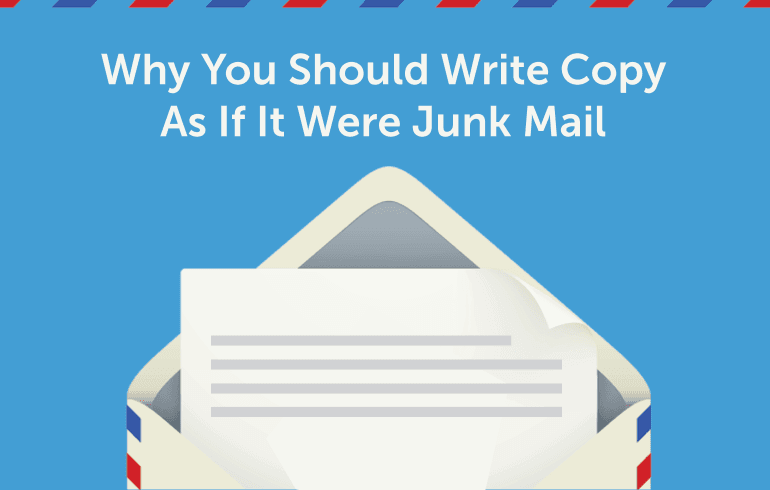 Are you ashamed at how vulnerable you are to junk mail?
Direct response letters are part of the pantheon of junk mail. Or at least, that’s one way to look at them. They are those letters that arrive that sell a product or solicit a donation from you, the main reason the postal service is probably still in business.
Yet direct response letters are an example of copywriting that can be extremely effective in getting your reader to take action. And, in that sense, they are not junk mail.
They’re a copywriting gold mine.
Are you ashamed at how vulnerable you are to junk mail?
Direct response letters are part of the pantheon of junk mail. Or at least, that’s one way to look at them. They are those letters that arrive that sell a product or solicit a donation from you, the main reason the postal service is probably still in business.
Yet direct response letters are an example of copywriting that can be extremely effective in getting your reader to take action. And, in that sense, they are not junk mail.
They’re a copywriting gold mine.
How To Write The Best Copy Ever With Advice From Junk Mail via @JulieNeidlinger
Click To Tweet- Indirect response is copy that eventually leads to a purchase over time by building trust and awareness.
- Direct response pushes for a purchase immediately, at the end of that copy. That means that direct response copywriting is easily tested; you’ll know quickly whether your copy is working or not.
Bill Jayme, Direct Response Extraordinaire
In the 20th century, Bill Jayme’s direct response copywriting (via mail) was second to none. He was the king of the direct response mailed letter with clients lining up to pay him to write their letter. One of his better-known examples was something he wrote to help launch the magazine Psychology Today. Jayme also wrote the copy for the envelope, and for this particular piece, he posed a provocative headline: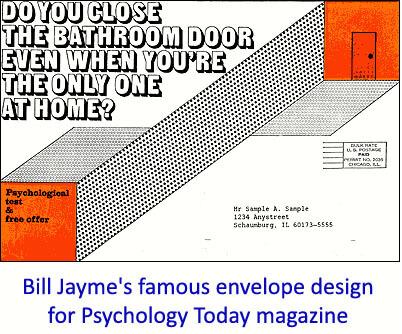 From Mike Capuzzi’s blog post on provocative headlines.
The envelope needed to be opened, just like your marketing emails need to be opened, just like your blog posts need to be read.
Jayme wrote a headline that piqued curiosity, and then combined it with a free take-it-now psychological test and another free offer. Whether a person answered yes or no to the question was irrelevant. It got them in the door.
Marketer Gary Elwood suggests that Jayme was successful with his direct response copywriting because he took an unorthodox approach combining both the visual design of envelopes with powerful copy techniques that included:
From Mike Capuzzi’s blog post on provocative headlines.
The envelope needed to be opened, just like your marketing emails need to be opened, just like your blog posts need to be read.
Jayme wrote a headline that piqued curiosity, and then combined it with a free take-it-now psychological test and another free offer. Whether a person answered yes or no to the question was irrelevant. It got them in the door.
Marketer Gary Elwood suggests that Jayme was successful with his direct response copywriting because he took an unorthodox approach combining both the visual design of envelopes with powerful copy techniques that included:
- Using mystery and intrigue. How do you get people to open envelopes? To read? You make them curious. Jayme frequently asked questions or used cliffhangers to get people to proceed.
- Involving readers psychologically. Jayme would ask seemingly strange questions that would pull readers in. Questions such as, “Are you embarrassed to eat in a restaurant alone?” or “How much should you tip the waitress, when you’re planning to steal the ashtray?” are effective, regardless of whether the reader answers yes or no. They’ll keep reading to find out what their answer means.
- Using urgency. Jayme would create scarcity by suggesting there was only a limited quantity or a limited time. Scarcity motivates people. No one wants to be left out.
- Turning the service/product into something else. Jayme never lied about the product or service for sale, but he turned it into something more valuable. For example, you’re not selling a financial magazine, you’re selling knowledge that will make someone a savvy investor and ultimately more rich.
- Saying the word “free.” Jayme used the word “free” in as many ways as possible, even providing an example: ‘Free gift comes to you with our compliments gratis—on the house. It’s yours to keep as an outright present without cost or charge—not a penny!' That’s about eight ways to say “free” in two sentences!
- Using exciting words. The words Jayme used were not boring. They often had cacophony to their sound and excitement in their meaning. They were words that caught attention, such as: dead, naked, free.
- Knowing who was reading. In order to ask the right provocative question, Jayme had to know what buttons to push. And that meant understanding the reader a bit. Elwood uses an excellent example of this: promotional copy for Coastal Living said, “If you love the shore, this new magazine will do you a world of good.” The first five words establish who the audience is that Jayme was targeting.
- The Gary Halbert Letter: Gary Halbert has used classic direct response copywriting techniques in his pared down website. Read some of his copy to get an idea of how direct response copy sounds.
- “Junk Mail’s Top Dogs”: New York Times article that covers the history of the practice, and highlights Bill Jayme’s work.
- Bill Jayme’s “Cool Friday” letter: A wildly successful direct response letter Jayme wrote for Life Magazine, considered a classic in the genre.
- Armageddon Advertising: Putting fear into readers might not be the best route for you, but studying “armageddon advertising” is still a useful learning tool, as it taps into reader psychology.
Learn From Direct Response Copy Examples
Clearly, direct response “junk mail” is powerful, even if we think it’s cheesy and doesn’t work. Because it does work, even on marketers who know what’s up. John Jantsch, from DuctTapeMarketing, pulled together some examples of sales letters, and extracted the foundation of what made them tick:- They use a headline. There is always some sort of startling, attention-grabbing headline at work in a sales letter. Whether it was on the outside of the envelope or in the letter itself, the success of the sales letter hinged on this.
- They demonstrate how a reader benefits. The copy of a sales letter isn’t telling the reader how great the company or product is. Instead, they show how the reader will have a better life if they buy.
- They offer something logical. There must be an offer, of course, or it wouldn’t be a sales letter. But that offer must, by the time the reader gets to the end of the letter, make sense. Ads don’t offer anything. They announce sales and product prices. Too often, our copy does the same. There is a difference between an offer and an ad. The best offer is a deal that can’t be refused.
“If Your Name Is On This Letter”
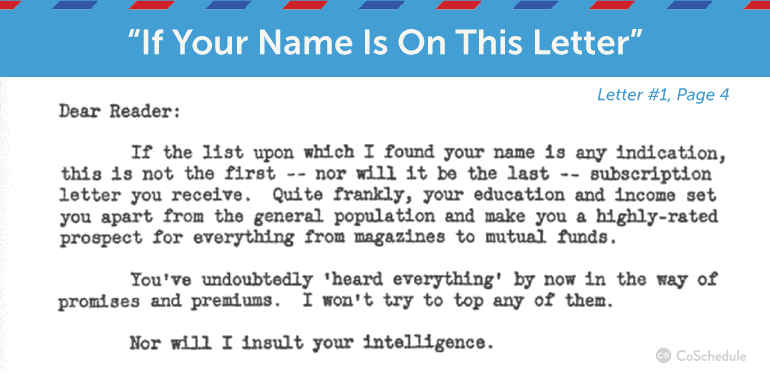 In this example of a letter from Newsweek, readers were encouraged to subscribe to the magazine.
This type of sales copy, according to Jantsch, feeds into reader vanity.
It suggests there is exclusivity at work and that the reader, should the offer apply to them, is special. Otherwise, if the offer isn’t of interest to them, they are common. This copy relies heavily on the second person (“you”), and often starts out describing what isn’t (the negative) instead of what is (the positive).
In this example of a letter from Newsweek, readers were encouraged to subscribe to the magazine.
This type of sales copy, according to Jantsch, feeds into reader vanity.
It suggests there is exclusivity at work and that the reader, should the offer apply to them, is special. Otherwise, if the offer isn’t of interest to them, they are common. This copy relies heavily on the second person (“you”), and often starts out describing what isn’t (the negative) instead of what is (the positive).
Writing to sell? Tell your reader they're special, offer exclusivity, guarantee enrichment.
Click To Tweet“Two Young Men”
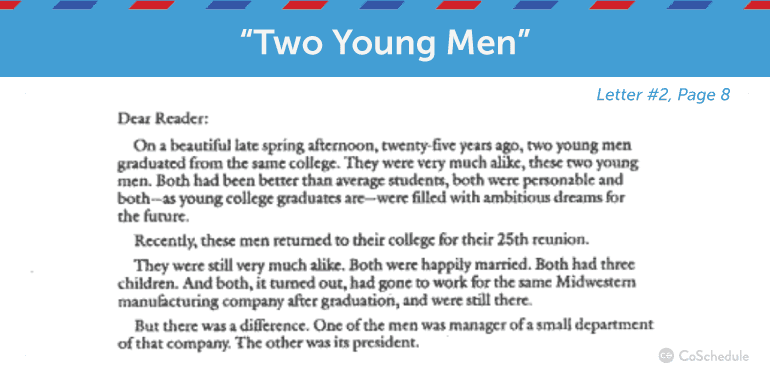 The next example Jantsch uses is from the Wall Street Journal. This direct sales copy uses a story (which readers love) to promise readers success if they buy (and suggest a warning if they don’t).
The Wall Street Journal starts with a simple paragraph telling the story of two young men who met back during a 25th college reunion. One man was a success, the other was not. The letter then proceeds in sections, outlining what made the difference between the two men (knowledge provided by the publication, in this case), and how that applies to the reader.
The next example Jantsch uses is from the Wall Street Journal. This direct sales copy uses a story (which readers love) to promise readers success if they buy (and suggest a warning if they don’t).
The Wall Street Journal starts with a simple paragraph telling the story of two young men who met back during a 25th college reunion. One man was a success, the other was not. The letter then proceeds in sections, outlining what made the difference between the two men (knowledge provided by the publication, in this case), and how that applies to the reader.
“Dirty Hands”
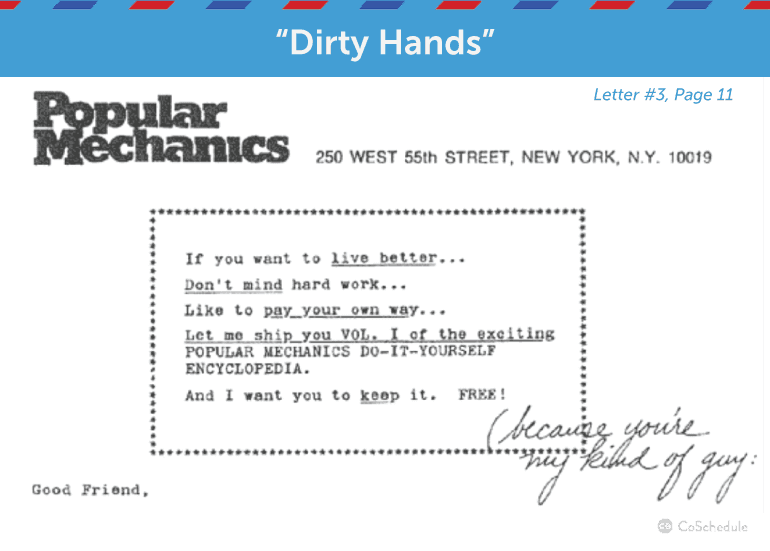 The third letter example in Jantsch’s ebook is from Popular Mechanics, and uses a couple of unique things. The letter itself has a visual box at the top, filled with brief copy that establishes whether the reader is the right audience using vanity and rather obvious qualifications we all want to assign to ourselves.
“If you want to live better, don’t mind hard work, like to pay your own way…”
The rest of the copy works very hard at appealing not to the elitist, but to the “average Joe”. It’s filled with homey phrases that promote elbow grease, hard work, and flag-waving.
The third letter example in Jantsch’s ebook is from Popular Mechanics, and uses a couple of unique things. The letter itself has a visual box at the top, filled with brief copy that establishes whether the reader is the right audience using vanity and rather obvious qualifications we all want to assign to ourselves.
“If you want to live better, don’t mind hard work, like to pay your own way…”
The rest of the copy works very hard at appealing not to the elitist, but to the “average Joe”. It’s filled with homey phrases that promote elbow grease, hard work, and flag-waving.
Write to sell: Appeal as understanding, offer just for them, give away a bonus for free.
Click To Tweet“Quite Frankly”
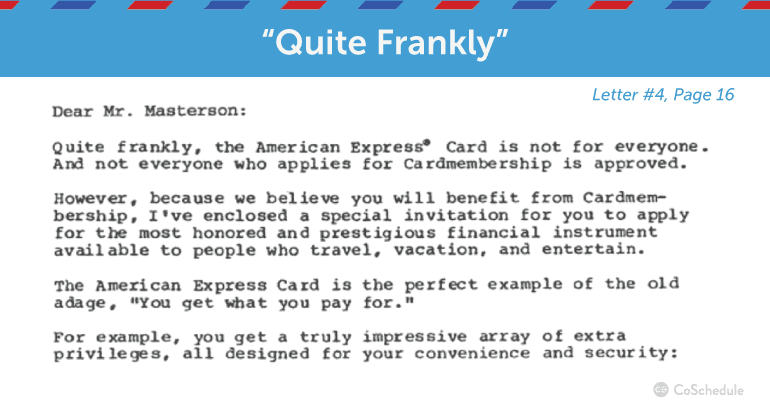 This letter example, from American Express, relies heavily on exclusivity. More than anything, we all like to know we’re good enough to be part of an elite and exclusive club, and (shamefully) that other people won’t get in.
Compared to the other letters, this letter isn’t particularly long. It’s main punch is in two sentences in the opening paragraph, making a point to say that not everyone who applies to get the card will, and that such a card isn’t for everyone. The rest of the letter is a list of the perks and benefits the card provides.
This letter example, from American Express, relies heavily on exclusivity. More than anything, we all like to know we’re good enough to be part of an elite and exclusive club, and (shamefully) that other people won’t get in.
Compared to the other letters, this letter isn’t particularly long. It’s main punch is in two sentences in the opening paragraph, making a point to say that not everyone who applies to get the card will, and that such a card isn’t for everyone. The rest of the letter is a list of the perks and benefits the card provides.
“A Story About Grandmother”
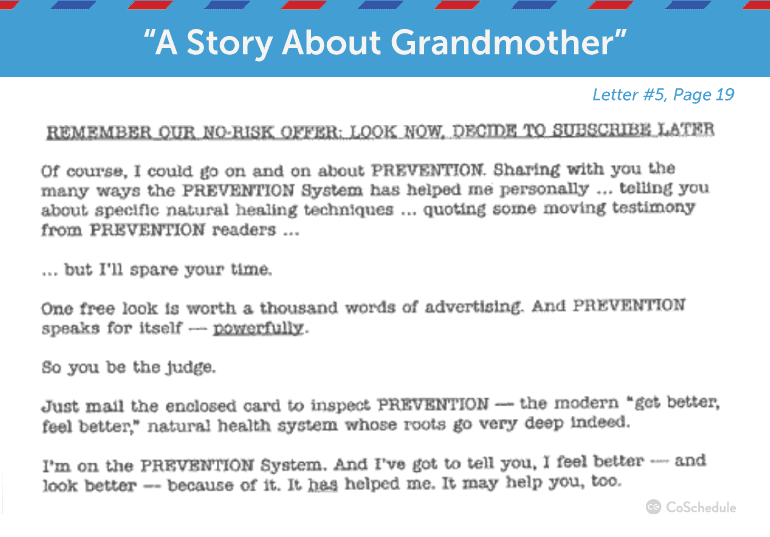 Using the story approach, this letter writes in first person and tells of memories of grandma. It’s very personal and approachable, and draws the reader in immediately. This letter is for Prevention magazine, and uses memories of healthy food vs. chemical-laden food, and the need to better understand how things had changed since the time of those grandma memories.
The reader then learns about how the magazine can help them, being quite direct as to how it will make their lives better. In some sense, it taps into fear, suggesting that even their doctor isn’t telling them all they need to know. For all of us, the fear that we are being kept in the dark is a highly motivating one.
The letter closes with bonuses that the reader could receive, and Jantsch notes that some people will buy based on the bonuses they get when making the initial purchase. So do offer bonuses.
Using the story approach, this letter writes in first person and tells of memories of grandma. It’s very personal and approachable, and draws the reader in immediately. This letter is for Prevention magazine, and uses memories of healthy food vs. chemical-laden food, and the need to better understand how things had changed since the time of those grandma memories.
The reader then learns about how the magazine can help them, being quite direct as to how it will make their lives better. In some sense, it taps into fear, suggesting that even their doctor isn’t telling them all they need to know. For all of us, the fear that we are being kept in the dark is a highly motivating one.
The letter closes with bonuses that the reader could receive, and Jantsch notes that some people will buy based on the bonuses they get when making the initial purchase. So do offer bonuses.
Putting Direct Response Methodology To Work
Direct sales letter writing techniques are directly applicable to your landing pages, of course, but also some of your blog posts. Challenge: The next time a direct sales letter arrives, don’t throw it. Dissect it. Figure out what they are doing in that copy, and what makes it work (or fail). Or, do some online searches and find more examples of direct response letters, or landing pages that employ the same techniques.- Do you feel motivated to buy at the end? Why or why not?
- What is the writer appealing to? Fear, vanity, trust?
- How long is the copy? How many words?
- How is the offer presented? Are there bonuses?
- Is the copy written in first or second person?
How To Use Junk Mail As Your Direct Response Copywriting Jackpot
Click To Tweet

